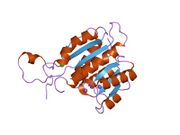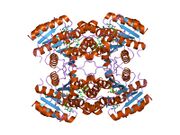Biology:HSD17B10
 Generic protein structure example |
17-β-Hydroxysteroid dehydrogenase X (HSD10) also known as 3-hydroxyacyl-CoA dehydrogenase type-2 is a mitochondrial enzyme that in humans is encoded by the HSD17B10 (hydroxysteroid (17β) dehydrogenase 10) gene.[1][2][3][4][5] Several alternatively spliced transcript variants have been identified, but the full-length nature of only two transcript variants has been determined.[6] Human HSD10 cDNA was cloned from brain (NM_004493), and the resulting protein, a homotetramer, was first characterized as a short chain 3-hydroxyacyl-CoA dehydrogenase (SCHAD).[7] Active sites of this enzyme can accommodate different substrates; 17β-HSD10 is involved in the oxidation of isoleucine, branched-chain fatty acids, and xenobiotics as well as the metabolism of sex hormones and neuroactive steroids.[8][9]
Function
17beta-hydroxysteroid dehydrogenase 10 is a member of the short-chain dehydrogenase/reductase superfamily.[10] This homotetrameric mitochondrial multifunctional enzyme catalyzes the oxidation of neuroactive steroids and the degradation of isoleucine.[11] This enzyme is capable of binding to other peptides, such as estrogen receptor α, amyloid-β, and tRNA methyltransferase 10C. Missense mutations of the HSD17B10 gene result in 17β-HSD10 deficiency, an infantile neurodegeneration characterized by progressive psychomotor regression and alteration of mitochondria morphology. 17β-HSD10 exhibits only a negligible alcohol dehydrogenase activity, and is not localized in the endoplasmic reticulum or plasma membrane. Its alternate name – Aβ binding alcohol dehydrogenase (ABAD) – is a misnomer predicated on the mistaken belief that this enzyme is an alcohol dehydrogenase.[9]
Structure
Gene
Human HSD17B10 gene has 6 exons resides on the X chromosome at p11.22.[6]
Protein
The gene product is a mitochondrial protein that catalyzes the oxidation of a wide variety of fatty acids and steroids, and is a subunit of mitochondrial ribonuclease P, which is involved in tRNA maturation.[6] The molecular weight of 17β-HSD10 that is composed of four identical subunits is 108 kDa; each subunit consists of 261 amino acid residues.[12] Although the endoplasmic reticulum (ER)-associated amyloid-β peptide binding protein (ERAB) was reported to be associated with the ER and to consist of 262 residues with a molecular weight of 27 kDa,[13] ERAB is actually identical to 17β-HSD10 that is localized in mitochondria but not ER.[3]
Clinical significance
Abnormal expression, as well as mutations of the HSD17B10 gene leads to impairment of the structure, function, and dynamics of mitochondria. This may underlie the pathogenesis of the synaptic and neuronal deficiency exhibited in 17β-HSD10 related diseases, including 17β-HSD10 deficiency and Alzheimer's disease (AD).[6] Missense and silent mutations in the gene are the cause of hydroxysteroid (17β) dehydrogenase X (HSD10) deficiency, formerly MHBD deficiency, and X-linked mental retardation, choreoathetosis, and abnormal behavior (MRXS10), respectively.[11][14][15] Restoration of steroid homeostasis could be achieved by the supplementation of neuroactive steroids with a proper dosing and treatment regimen or by the adjustment of 17β-HSD10 activity to protect neurons.[9] The discovery of this enzyme's true function has opened a new therapeutic avenue for treating AD.
Interactions
HSD17B10 has been shown to interact with Amyloid precursor protein.[8]
References
- ↑ "Comparative evolutionary genomics of the HADH2 gene encoding Abeta-binding alcohol dehydrogenase/17beta-hydroxysteroid dehydrogenase type 10 (ABAD/HSD10)". BMC Genomics 7: 202. Sep 2006. doi:10.1186/1471-2164-7-202. PMID 16899120.
- ↑ "Hydroxysteroid (17β) dehydrogenase X in human health and disease". Molecular and Cellular Endocrinology 343 (1–2): 1–6. Aug 2011. doi:10.1016/j.mce.2011.06.011. PMID 21708223.
- ↑ 3.0 3.1 "Human brain short chain L-3-hydroxyacyl coenzyme A dehydrogenase is a single-domain multifunctional enzyme. Characterization of a novel 17beta-hydroxysteroid dehydrogenase". The Journal of Biological Chemistry 274 (21): 15014–9. May 1999. doi:10.1074/jbc.274.21.15014. PMID 10329704.
- ↑ "The SDR (short-chain dehydrogenase/reductase and related enzymes) nomenclature initiative". Chemico-Biological Interactions 178 (1–3): 94–8. Mar 2009. doi:10.1016/j.cbi.2008.10.040. PMID 19027726.
- ↑ "RNase P without RNA: identification and functional reconstitution of the human mitochondrial tRNA processing enzyme". Cell 135 (3): 462–74. Oct 2008. doi:10.1016/j.cell.2008.09.013. PMID 18984158.
- ↑ 6.0 6.1 6.2 6.3 "Entrez Gene: HSD17B10 hydroxysteroid (17-beta) dehydrogenase 10". https://www.ncbi.nlm.nih.gov/sites/entrez?Db=gene&Cmd=ShowDetailView&TermToSearch=3028.
- ↑ "Intrinsic alcohol dehydrogenase and hydroxysteroid dehydrogenase activities of human mitochondrial short-chain L-3-hydroxyacyl-CoA dehydrogenase". The Biochemical Journal 345 (1): 139–43. Jan 2000. doi:10.1042/bj3450139. PMID 10600649.
- ↑ 8.0 8.1 "An intracellular protein that binds amyloid-beta peptide and mediates neurotoxicity in Alzheimer's disease". Nature 389 (6652): 689–95. Oct 1997. doi:10.1038/39522. PMID 9338779. Bibcode: 1997Natur.389..689D.
- ↑ 9.0 9.1 9.2 "Roles of 17β-hydroxysteroid dehydrogenase type 10 in neurodegenerative disorders". The Journal of Steroid Biochemistry and Molecular Biology 143: 460–72. Sep 2014. doi:10.1016/j.jsbmb.2014.07.001. PMID 25007702.
- ↑ "Multiple functions of type 10 17beta-hydroxysteroid dehydrogenase". Trends in Endocrinology and Metabolism 16 (4): 167–75. 2005. doi:10.1016/j.tem.2005.03.006. PMID 15860413.
- ↑ 11.0 11.1 "Mental retardation linked to mutations in the HSD17B10 gene interfering with neurosteroid and isoleucine metabolism". Proceedings of the National Academy of Sciences of the United States of America 106 (35): 14820–4. Sep 2009. doi:10.1073/pnas.0902377106. PMID 19706438. Bibcode: 2009PNAS..10614820Y.
- ↑ "A human brain L-3-hydroxyacyl-coenzyme A dehydrogenase is identical to an amyloid beta-peptide-binding protein involved in Alzheimer's disease". The Journal of Biological Chemistry 273 (17): 10741–6. Apr 1998. doi:10.1074/jbc.273.17.10741. PMID 9553139.
- ↑ "Alzheimer's disease. The ins and outs of amyloid-beta". Nature 389 (6652): 677–8. Oct 1997. doi:10.1038/39479. PMID 9338775. Bibcode: 1997Natur.389..677B.
- ↑ "A novel mutation in the HSD17B10 gene of a 10-year-old boy with refractory epilepsy, choreoathetosis and learning disability". PLOS ONE 6 (11): e27348. November 2011. doi:10.1371/journal.pone.0027348. PMID 22132097. Bibcode: 2011PLoSO...627348S.
- ↑ "The reduced expression of the HADH2 protein causes X-linked mental retardation, choreoathetosis, and abnormal behavior". American Journal of Human Genetics 80 (2): 372–7. Feb 2007. doi:10.1086/511527. PMID 17236142.
Further reading
- "Human short-chain L-3-hydroxyacyl-CoA dehydrogenase: cloning and characterization of the coding sequence". Biochemical and Biophysical Research Communications 223 (3): 718–23. Jun 1996. doi:10.1006/bbrc.1996.0961. PMID 8687463.
- "3-Hydroxyacyl-CoA dehydrogenase and short chain 3-hydroxyacyl-CoA dehydrogenase in human health and disease". The FEBS Journal 272 (19): 4874–83. Oct 2005. doi:10.1111/j.1742-4658.2005.04911.x. PMID 16176262.
- "HSD17B10: a gene involved in cognitive function through metabolism of isoleucine and neuroactive steroids". Molecular Genetics and Metabolism 92 (1–2): 36–42. 2007. doi:10.1016/j.ymgme.2007.06.001. PMID 17618155.
- "Cloning and expression of cDNA for a newly identified isozyme of bovine liver 3-hydroxyacyl-CoA dehydrogenase and its import into mitochondria". Biochimica et Biophysica Acta (BBA) - Gene Structure and Expression 1350 (3): 317–24. Feb 1997. doi:10.1016/s0167-4781(96)00171-6. PMID 9061028.
- "A human brain L-3-hydroxyacyl-coenzyme A dehydrogenase is identical to an amyloid beta-peptide-binding protein involved in Alzheimer's disease". The Journal of Biological Chemistry 273 (17): 10741–6. Apr 1998. doi:10.1074/jbc.273.17.10741. PMID 9553139.
- "Chromosomal basis of X chromosome inactivation: identification of a multigene domain in Xp11.21-p11.22 that escapes X inactivation". Proceedings of the National Academy of Sciences of the United States of America 95 (15): 8709–14. Jul 1998. doi:10.1073/pnas.95.15.8709. PMID 9671743. Bibcode: 1998PNAS...95.8709M.
- "The gene for the Alzheimer-associated beta-amyloid-binding protein (ERAB) is differentially expressed in the testicular Leydig cells of the azoospermic by w/w(v) mouse". European Journal of Biochemistry 258 (1): 53–60. Nov 1998. doi:10.1046/j.1432-1327.1998.2580053.x. PMID 9851691.
- "Binding of amyloid beta-peptide to mitochondrial hydroxyacyl-CoA dehydrogenase (ERAB): regulation of an SDR enzyme activity with implications for apoptosis in Alzheimer's disease". FEBS Letters 451 (3): 238–42. May 1999. doi:10.1016/S0014-5793(99)00586-4. PMID 10371197.
- "Intrinsic alcohol dehydrogenase and hydroxysteroid dehydrogenase activities of human mitochondrial short-chain L-3-hydroxyacyl-CoA dehydrogenase". The Biochemical Journal 345 (1): 139–43. Jan 2000. doi:10.1042/bj3450139. PMID 10600649.
- Role of type 10 17beta-hydroxysteroid dehydrogenase in the pathogenesis of Alzheimer's disease. 487. 2001. 101–10. doi:10.1007/978-1-4615-1249-3_8. ISBN 978-1-4613-5461-1.
- "Deposition of Alzheimer's vascular amyloid-beta is associated with decreased expression of brain L-3-hydroxyacyl-coenzyme A dehydrogenase (ERAB)". Brain Research 907 (1–2): 44–53. Jul 2001. doi:10.1016/S0006-8993(01)02497-0. PMID 11430884.
- "Characterization and localization of human type10 17beta-hydroxysteroid dehydrogenase". European Journal of Biochemistry 268 (18): 4899–907. Sep 2001. doi:10.1046/j.0014-2956.2001.02421.2421.x. PMID 11559359.
- "Abundant type 10 17 beta-hydroxysteroid dehydrogenase in the hippocampus of mouse Alzheimer's disease model". Brain Research. Molecular Brain Research 99 (1): 46–53. Feb 2002. doi:10.1016/S0169-328X(02)00102-X. PMID 11869808.
- "2-Methyl-3-hydroxybutyryl-CoA dehydrogenase deficiency is caused by mutations in the HADH2 gene". American Journal of Human Genetics 72 (5): 1300–7. May 2003. doi:10.1086/375116. PMID 12696021.




